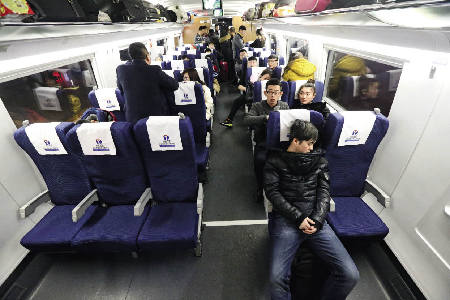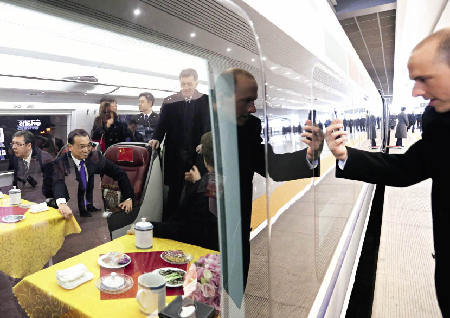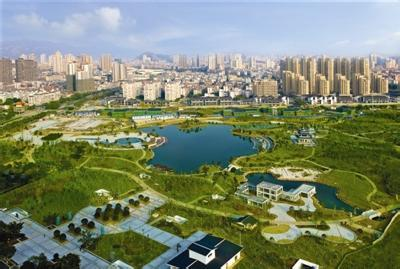Tales of Two Cities
By staff reporter HU YUE
WHEN Guo Xinyu boarded the Beijing-Tianjin intercity high-speed train at Beijing South Railway Station in the early morning of November 20, 2015, he thought the train might be overcrowded because of the weekend’s heavy snowfall.
Guo, 41, lives in Tianjin. He previously worked at the China Huaneng Group in Yangliuqing in Tianjin before his promotion to a supervisory job at the group’s Beijing headquarters in 2011. To be with his family, he still lives in Tianjin. This means he has chosen to live a “tale of two cities.” The Beijing-Tianjin Intercity Rail is now an inextricable part of his life.
|
|
|
Most seats are occupied and the luggage rack is full in a car of a train departing from Beijing after midnight. |
Extending Life’s Radius
“Other than when I’m away on business, I usually take four to five round trips between Beijing and Tianjin every week, spending at most one night in Beijing,” said Guo, whose daughter is now in fourth grade. “It’s only for a few years that kids fully rely on their parents. I don’t want to miss them and later regret it.” As a father, Guo is responsible, but at the cost of more commuting time and less cash in his wallet.
Extending a total length of 115 kilometers, an end-to-end ride on the Beijing-Tianjin Intercity Rail takes 30 minutes. The bullet trains depart every 10 minutes. A one-way ticket costs RMB 54.5, and a round-trip ticket RMB 109. Compared to paying Beijing rents and home prices, however, commuting between the two cities is relatively cheap and practicable.
Wang Xueying, a Tianjin native who works near Chaoyangmen, Beijing, used to live alone in a rented apartment in the Beijing suburb of Tongzhou. After talking to her parents, she decided to start taking the Intercity train home every day. She explained: “The rush-hour commuter flow to and fro is a raging torrent, and the peak-time overcrowding on public transport in Beijing is enough to make you want to die.” More importantly, as a single girl living alone, Wang had to cook for herself, do chores and spend her after-work hours in her own company. Now she takes the subway and Intercity train between home and her workplace every day. She is then escorted home by her father who waits at Tianjin Station. This takes one hour. She eats a dinner cooked by her mother, followed by quality time spent with family. By commuting, she also spends less than she would on renting a Beijing apartment. Wang says: “The Intercity rail makes Beijing and Tianjin one city. I used to spend more time en route to work, and then to my rented home in the suburbs during rush hour. Now I live at my parents’ place, but I don’t know how long this can last.”
China now boasts a high-speed railway network for passenger transport. This not only affords commuters convenience, but also extends the radius of people’s lives by dramatically shortening inter-city distances. Moreover, the connected railway stations and urban rail transit systems have proven successful solutions. For example, the two terminuses of the Beijing-Tianjin Intercity Rail connect directly to the two municipal subways – Line 4 and Line 14 in Beijing. This enables direct access to the subway network, and Line 3 and Line 9 in Tianjin, with similar convenience. It not only saves time, but also reduces to a minimum the impact of bad weather.
Network of Convenience
To serve the Beijing Olympics, China’s first high-speed passenger transport line, the Beijing-Tianjin Intercity Rail, inaugurated operations in August 2008. It runs a length of 115 kilometers and enables travel between the two cities in 30 minutes. A month after opening, its extension line reached Binhai, Tianjin, transforming it into a golden transit thread connecting Beijing with Tianjin’s port. It thus facilitated the economic integration of the region. As China develops four major passenger lines crisscrossing the country from north to south and west to east, sharing the human resources of adjacent cities is becoming ever easier. More young professionals are hence choosing to live a “tale of two cities.”
Recalling the difficult times before the high-speed rail, Guo Xinyu said: “Before my promotion, I often traveled to the Beijing headquarters for meetings or other business. In 2007, the ride was on one of the red trains and took 75 minutes. I was content with that because before the red train, there was only the green train, which took three hours and had no air conditioning or heating. It was excruciating both in summer and winter.”
Many people share Guo’s feeling. Ms. Zhang Limin, a resident of Binhai New Area, Tianjin, now spends most of her time in Beijing babysitting her grandchild. In 2001, her daughter enrolled in a Beijing university. She stayed after graduation, got married and bore a child. Before the high-speed rail, Ms. Zhang and her daughter usually took an expressway bus to visit each other. She says: “It was very awkward taking the train back then. There was only the K215 from Beijing to Tumen (in Jilin Province) that passed Tanggu (in Tianjin), and the train stopped at every whistle-stop along the way. It was slow and crowded, and the air inside the carriages was filthy. But taking an expressway bus was just too dangerous. I was always worried for my daughter’s safety when she came home by coach.”
Now, Ms. Zhang takes the Beijing-Tianjin Rail back to Binhai each Friday evening to spend the weekend with her husband. She then returns to Beijing on Sunday afternoon to babysit weekdays while her daughter is at work. She says jocularly: “My husband and I are living the young people’s life.”
The high-speed railway network has also made life easier in Shanghai and other cities in the Jiangsu-Zhejiang region. On November 25, 2015, Chinese Premier Li Keqiang invited heads of Central and Eastern European countries attending the fourth China-CEEC leaders meeting in Suzhou to take a high-speed rail trip from Suzhou North Station to Shanghai Hongqiao Station. They traversed a length of 100 kilometers in 20 minutes.
|
|
|
Chinese Premier Li Keqiang invites participants in the Fourth Summit of China and Central and Eastern European Countries held last November in China to take a high-speed rail trip. |
The Pleasure of a “High-Speed Rail Man”
In four years Guo Xinyu has experienced only one delay and one malfunction on the high-speed railway. He is quite okay with this, and would opt for the train over the plane for any business trip of less than five hours in duration.
To better serve passengers, the China Railway Group issued a prepaid card in 2012, allowing commuters a quick swipe-in to board the train. Guo says: “I saw a report which said that over 70,000 people now have the card, and 50,000 are riding the train 165 times each year, like me. We are a huge group.”
The prepaid card had a prototype, but one which did not book passengers an assigned cabin or seat. So they sat at random, having to constantly yield their seats to ticket-holders with reserved spots. Fights even broke out over seats. Later the prototype card was replaced, and receipt printers were installed at stations for card-holders to print out their seat numbers before swiping their cards. This proved much more orderly and efficient. Guo said: “There is still one technical glitch: If the card is lost, this can be reported, but the remaining balance is non-recoverable. I lost a card once, with all the money on it. After that I stopped putting a lot of money on the card.”
Aside from his co-workers who also take the train, Guo has made other friends during his daily commuting routine. He says: “I recognize a lot of faces on the Intercity train, and we talk sometimes. One group of people used to ride the early morning train to a wholesale market in Beijing, but I seldom see them now since the market has relocated to Tianjin.”
Cities should develop towards an orientation of providing people with greater convenience. The high-speed rail, as a link between cities, has bestowed more choices on urbanites.



